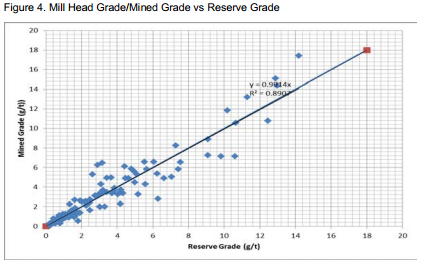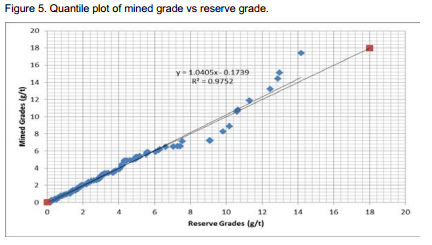Adam Simmons, Ph.D. Geology and Investment Advisor at PI Financial, who co-author's the Digging Through The Dirt newsletter with fellow IA's Bill Whitehead and Justin Hayek, has done a simple comparison of reserve grades to mined grades and found little variation.
"Simply put the mine plan dictates the grade produced and not the commodity prices or market conditions."
Mr. Simmons suspects cost saving measures are coming in other places such as cuts to exploration and development expenditures as well as staff.
Here's an excerpt from the latest Digging Through The Dirt newsletter:
Random Thoughts
Based on a colleague’s suggestion that producing gold companies are high grading their mines to make their mines more profitable, he suggested it would be interesting to look at the reserve grades of the gold mines vs their mill head grades. I thought this would be an interesting exercise that may establish if this was indeed taking place. Since I currently maintain a database of resources and reserves for over 130 producing gold mines globally it should be very easy to input the mill head grades from the last quarter for all of the companies I track. While I will admit that the list of companies is not complete, it does contain the most of the world’s top 10 gold miners (by ounces produced) and provides a good cross-section of the industry. Included in this list is( in no particular order): Kinross, Osisko, IAMGold, Agnico Eagle, Newmont, Barrick, Goldcorp, Anglogold, Eldorado, Yamana, Polyus, Randgold, Goldfields and Centerra. There are a few holes in the data.
Firstly, the reserve numbers for about 75% of the mines are about one year out of date, but realistically these probably haven’t changed significantly in terms of grade. Secondly, some companies when reporting their mill head grades batch a region together as opposed to breaking down into individual mines, for example, Newmont batches their entire Nevada operations together, so they were not included in this dataset. With that said lets have a look at the data.
Based on this plot I see little to no high grading actually happening on a global basis. Though there is variation in the dataset it remains more or less one to one. When going into great detail within the dataset, I noted that Barrick and Newmont are the only companies consistently producing higher grades than their reserve grades. Note again that Newmont’s Nevada operations are not included in this. Additionally, there was a regional emphasis for mines located in Africa and Australia to produce higher grades than their reserve grades, though this is not a great correlation. Now, lets take the data set one step further and produce a quantile plot, which should eliminate mine by mine bias and look at the validity of the above statements on a broader data set scale.
This plot shows that for the most part there is little variation in the mined grades vs reserve grades, but does break down in the high grade mines beyond about 7/g/t. After eliminating mine by mine bias this again shows very little to no high grading is actually happening.
Although I don’t readily have the numbers together, I suspect where the “cost savings” may be coming from is by boosting production at more profitable mines and scaling back production at less profitable mines. In addition to “cutting out the fat” by scaling back exploration budgets, laying off staff that are not critical to their operations and perhaps scaling back compensation to executives and directors.
Simply put the mine plan dictates the grade produced and not the commodity prices or market conditions. That is once a mine plan is put in place there may not be an option to high grade the deposit any any given time, so the producers, for the most part have to remain committed to the mine plan.
That’s what I see from the data! An interesting exercise that I may be able to expand on in the future.
The April 2014 edition of Digging Through The Dirt PDF can be downloaded here.
Contact the gentlemen at PI Financial to subscribe.






![By Uncle Kick-Kick (Patrick Huber) (Round Mountain gold mine Uploaded by PDTillman) [CC-BY-SA-2.0 (http://creativecommons.org/licenses/by-sa/2.0)], via Wikimedia Commons](https://blog.ceo.ca/wp-content/uploads/2014/05/512px-Round_Mountain_gold_mine_aerial.jpg)

















